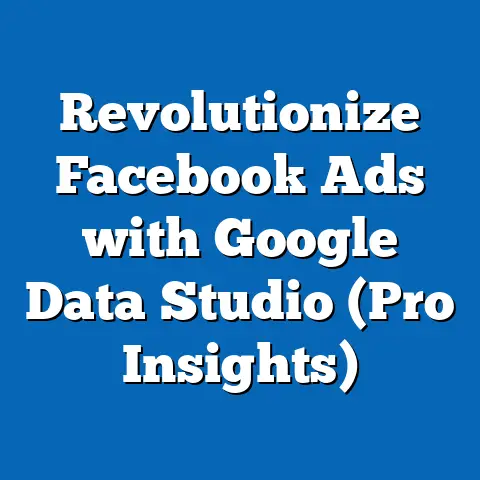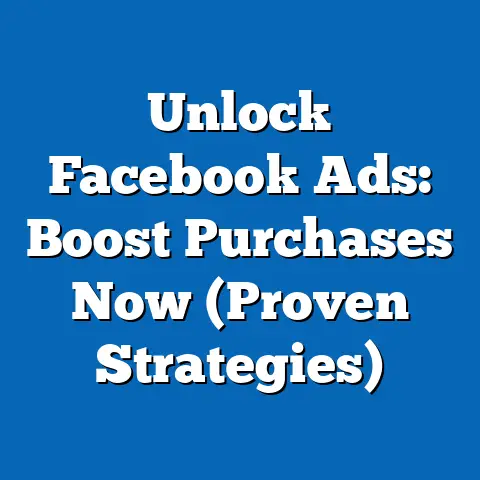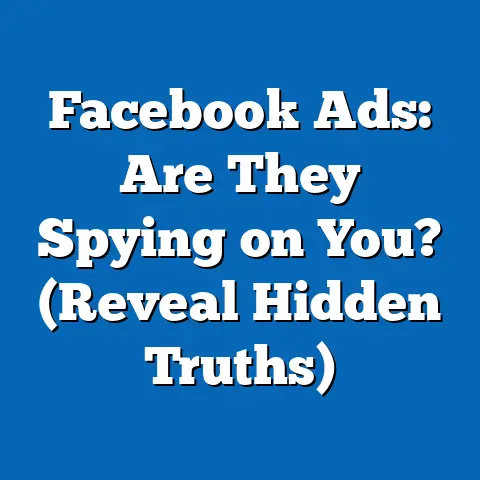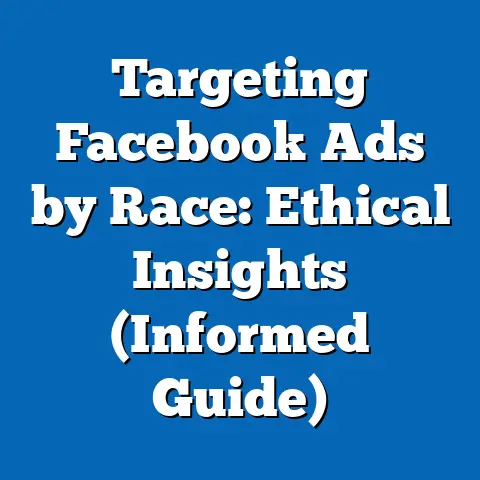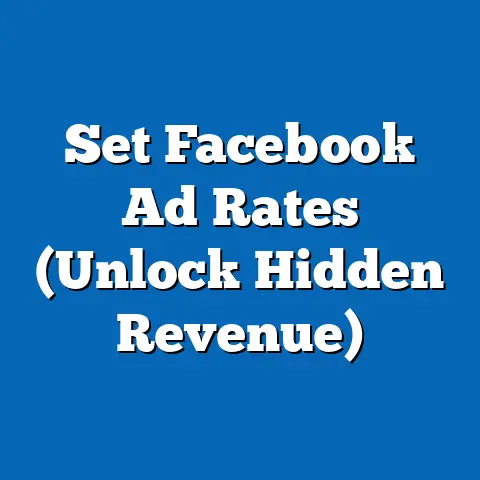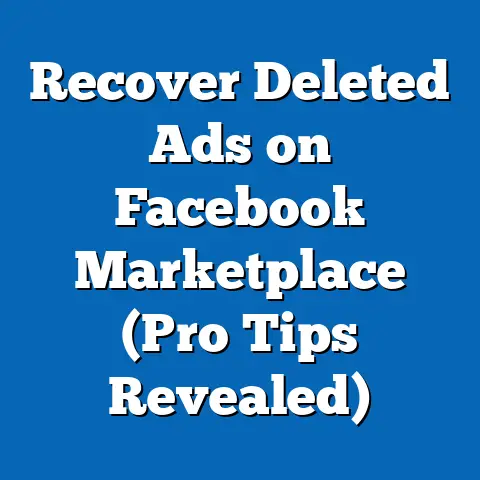Unlock Success with Facebook Ads Checklists (Essential Guide)
Unlock Success with Facebook Ads Checklists: The Essential Guide
Facebook is a giant – a social media behemoth with billions of active users. As marketers, we know this, but sometimes we get so caught up in the daily grind that we overlook the subtle yet powerful advantages this platform offers. It’s not just about throwing money at ads and hoping something sticks. It’s about strategic planning, meticulous execution, and continuous optimization. That’s where checklists come in.
The Undervalued Power of Facebook Ads
I remember when I first started with Facebook Ads; it felt like throwing darts in the dark. I’d create an ad, set a budget, and cross my fingers. Sometimes it worked, often it didn’t. It wasn’t until I started using checklists that I saw consistent, predictable results. Checklists forced me to think critically about every aspect of my campaigns, from audience targeting to ad creative.
Let’s face it, Facebook Ads can be a complex beast. But fear not! I’m here to guide you through the process, focusing on those hidden benefits that can truly elevate your campaigns.
1. Targeted Reach: Laser Focus on Your Ideal Customer
One of the biggest advantages of Facebook Ads is its unparalleled targeting capabilities. Unlike traditional advertising, where you’re essentially broadcasting your message to anyone who happens to be within earshot, Facebook allows you to laser-focus on specific demographics, interests, and behaviors.
Why this matters:
- Relevance is king: The more relevant your ad is to the viewer, the more likely they are to engage with it.
- Reduced ad waste: You’re not wasting money showing your ads to people who have no interest in your product or service.
- Higher conversion rates: When you target the right audience, you increase your chances of converting viewers into customers.
My Experience: I once worked with a local bakery that was struggling to attract new customers. Instead of running generic ads, we used Facebook’s targeting options to reach people who lived within a 5-mile radius of the bakery, had an interest in baking, and frequently visited coffee shops. The result? A significant increase in foot traffic and a surge in cake orders.
2. Cost-Effectiveness: Maximizing Your ROI
Many businesses shy away from advertising, fearing it’s too expensive. But Facebook Ads can be incredibly cost-effective, especially compared to traditional media like TV or print.
Why this matters:
- Budget control: You can set a daily or lifetime budget that suits your business’s financial capabilities.
- Bidding strategies: Facebook offers various bidding options, allowing you to optimize for different goals, such as clicks, impressions, or conversions.
- Performance tracking: You can monitor your ad performance in real-time and make adjustments to improve your ROI.
My Experience: I had a client who was hesitant to invest in Facebook Ads because they had a limited budget. We started with a small daily budget and focused on optimizing the ad creative and targeting. Within a few weeks, we were able to generate a significant number of leads at a fraction of the cost of their previous marketing efforts.
3. Real-Time Analytics: Data-Driven Decisions
One of the most powerful features of Facebook Ads is its robust analytics platform. You can track your ad performance in real-time, gaining valuable insights into what’s working and what’s not.
Why this matters:
- Immediate feedback: You don’t have to wait weeks or months to see if your ads are effective.
- Data-driven optimization: You can use the data to make informed decisions about your targeting, creative, and bidding strategies.
- Continuous improvement: By constantly monitoring and analyzing your ad performance, you can continuously improve your campaigns.
My Experience: I remember running a campaign for an e-commerce store that was selling handmade jewelry. Initially, the ads were generating a lot of clicks but not many sales. By analyzing the data, we discovered that the ads were performing well on mobile devices but not on desktop. We then optimized the ads for mobile users, resulting in a significant increase in sales.
4. Brand Awareness: Building Recognition and Trust
While many businesses focus on direct response advertising (e.g., generating leads or sales), Facebook Ads can also be a powerful tool for building brand awareness. Consistent ad presence can increase brand visibility and recognition, leading to long-term customer loyalty.
Why this matters:
- Top-of-mind awareness: When customers are ready to buy, they’re more likely to choose a brand they recognize.
- Trust and credibility: Consistent brand messaging can build trust and credibility with your target audience.
- Long-term growth: Brand awareness is a long-term investment that can pay off in increased sales and customer loyalty.
My Experience: I worked with a startup company that was launching a new line of organic skincare products. We ran a series of Facebook Ads focused on educating consumers about the benefits of organic skincare and showcasing the brand’s values. Over time, the brand became known for its commitment to sustainability and ethical sourcing, leading to a loyal customer base.
5. Engagement Opportunities: Fostering Community
Facebook Ads aren’t just about broadcasting your message; they’re also about fostering community interaction. Encourage comments, likes, and shares to create a sense of engagement and build relationships with your customers.
Why this matters:
- Social proof: When people see others engaging with your ads, they’re more likely to be interested in your product or service.
- Customer feedback: Comments and reviews can provide valuable feedback that you can use to improve your products or services.
- Word-of-mouth marketing: When people share your ads with their friends, they’re essentially becoming brand advocates.
My Experience: I ran a campaign for a local restaurant that encouraged customers to share their favorite dishes on Facebook. We offered a small discount to anyone who posted a photo of their meal with a specific hashtag. The campaign generated a ton of user-generated content and increased engagement with the restaurant’s Facebook page.
Section 1: Understanding Facebook Ads
Before we jump into the checklist, let’s make sure we’re all on the same page about how Facebook Ads work.
Ad Formats: A Canvas for Your Message
Facebook offers a variety of ad formats to suit different marketing goals. Here’s a quick rundown:
- Image Ads: Simple and effective, these ads feature a single image and some accompanying text. They’re great for showcasing products or services.
- Video Ads: Video ads are highly engaging and can be used to tell a story, demonstrate a product, or share a testimonial.
- Carousel Ads: Carousel ads allow you to showcase multiple images or videos in a single ad unit. They’re ideal for highlighting different features of a product or service.
- Collection Ads: These ads are designed for e-commerce businesses and allow customers to browse and purchase products directly from the ad.
- Instant Experience Ads: Also known as Canvas ads, these are full-screen, interactive ads that load instantly. They’re great for telling a compelling story or showcasing a product in detail.
- Lead Ads: These ads make it easy for people to sign up for newsletters, download ebooks, or request more information.
- Story Ads: These ads appear in the immersive story format, offering a full-screen experience that’s perfect for grabbing attention.
Placements: Where Your Ads Will Shine
Where your ads appear on Facebook can significantly impact their performance. Facebook offers a variety of placements, including:
- Facebook News Feed: This is the primary placement and where most users spend their time.
- Instagram Feed: If your target audience is active on Instagram, this is a great placement option.
- Facebook Stories: Stories are a highly engaging format, especially for younger audiences.
- Instagram Stories: Similar to Facebook Stories, this placement is ideal for reaching Instagram users.
- Facebook Marketplace: If you’re selling products, this placement can be very effective.
- Audience Network: This allows you to extend your reach beyond Facebook and Instagram to a network of mobile apps and websites.
Facebook Ads Manager: Your Command Center
The Facebook Ads Manager is your control panel for creating, managing, and analyzing your ad campaigns. It’s a powerful tool, but it can also be overwhelming for beginners. Here are some key features to familiarize yourself with:
- Campaigns: This is where you set your overall campaign objective (e.g., awareness, consideration, or conversion).
- Ad Sets: Ad sets allow you to define your target audience, budget, schedule, and placement options.
- Ads: This is where you create your ad creative (e.g., image, video, text).
- Reporting: The reporting dashboard allows you to track your ad performance and gain insights into what’s working and what’s not.
The Facebook Pixel: Tracking Conversions and Optimizing Ads
The Facebook pixel is a small snippet of code that you install on your website. It allows you to track conversions, optimize your ads, and build targeted audiences.
Why this matters:
- Conversion tracking: You can see which of your ads are driving sales, leads, or other desired actions.
- Ad optimization: Facebook can use the data from the pixel to optimize your ads for conversions.
- Retargeting: You can create audiences of people who have visited your website and retarget them with relevant ads.
Section 2: The Importance of Checklists in Ad Campaigns
Now that we’ve covered the basics of Facebook Ads, let’s talk about why checklists are so important.
Avoiding Costly Mistakes
I’ve seen countless businesses waste money on Facebook Ads because they missed a critical step in the ad creation process. Maybe they forgot to define their target audience, or they didn’t optimize their ad creative for mobile devices. Checklists help you avoid these costly mistakes by ensuring that you don’t overlook any important details.
Enhancing Efficiency and Effectiveness
Checklists can also enhance efficiency and effectiveness by streamlining your ad campaigns. By having a clear, step-by-step process to follow, you can save time and effort while also improving your results.
Streamlining Ad Campaigns
Top marketers use checklists to streamline their ad campaigns, ensuring they don’t miss any critical steps. This helps them to:
I’ve broken it down into three main categories: pre-campaign, creative, and post-campaign.Pre-Campaign Checklist: Laying the Foundation for Success
Before you even think about creating an ad, you need to lay the foundation for success. This involves defining your campaign objectives, identifying your target audience, setting a budget, and selecting your ad formats and placements.
Here’s a sample pre-campaign checklist:
- Define Campaign Objectives: What do you want to achieve with your Facebook Ads campaign? (e.g., increase brand awareness, generate leads, drive sales).
- Identify Target Audience Segments: Who are you trying to reach with your ads? (e.g., demographics, interests, behaviors).
- Conduct Audience Research: Use Facebook Audience Insights to gather data about your target audience.
- Set a Budget and Schedule: How much are you willing to spend on your campaign, and how long will it run?
- Select Ad Formats and Placements: Which ad formats and placements are most appropriate for your campaign objectives and target audience?
- Install Facebook Pixel: Ensure the Facebook pixel is properly installed on your website.
- Define Conversion Events: Set up conversion events to track desired actions on your website (e.g., purchases, sign-ups).
- Research Competitors: Analyze your competitors’ Facebook Ads to identify trends and opportunities.
- Compliance Check: Ensure your ads comply with Facebook’s advertising policies.
- Develop a Tracking System: How will you measure the success of your campaign? (Define KPIs)
Creative Checklist: Making Your Ads Stand Out
Your ad creative is what will grab people’s attention and entice them to take action. This involves writing compelling ad copy, designing eye-catching visuals, and ensuring compliance with Facebook’s ad policies.
Here’s a sample creative checklist:
- Write Compelling Ad Copy: Craft persuasive ad copy that resonates with your target audience.
- Use Strong Headlines: Capture attention with clear and concise headlines.
- Include a Clear Call to Action: Tell people what you want them to do (e.g., “Shop Now,” “Learn More,” “Sign Up”).
- Design Eye-Catching Visuals: Use high-quality images or videos that align with your brand identity.
- Optimize Visuals for Mobile: Ensure your visuals look good on mobile devices.
- Maintain Brand Consistency: Ensure your ad creative is consistent with your brand’s overall look and feel.
- A/B Test Different Ad Creatives: Experiment with different headlines, visuals, and calls to action to see what performs best.
- Ensure Compliance with Facebook’s Ad Policies: Review Facebook’s advertising policies to ensure your ads are compliant.
- Check Spelling and Grammar: Proofread your ad copy carefully to avoid errors.
- Get Feedback: Have someone else review your ad creative before you launch your campaign.
Post-Campaign Checklist: Analyzing and Optimizing
After your ad campaign ends, it’s important to analyze your performance metrics, gather insights for future campaigns, and engage with your audience based on campaign outcomes.
Here’s a sample post-campaign checklist:
- Analyze Performance Metrics: Track key metrics such as CTR, conversion rates, ROI, and cost per acquisition.
- Identify Key Trends and Insights: What worked well, and what didn’t?
- Gather Insights for Future Campaigns: Use what you learned to improve your future ad campaigns.
- Engage with Your Audience: Respond to comments and messages from people who interacted with your ads.
- Retarget Website Visitors: Create audiences of people who visited your website and retarget them with relevant ads.
- Update Customer Profiles: Enhance your customer profiles with data gathered from the campaign.
- Calculate ROI: Determine if the campaign met your objectives and was worth the investment.
- Document Findings: Create a report summarizing the campaign’s performance and key takeaways.
- Adjust Future Strategies: Based on your findings, make adjustments to your future Facebook Ads strategies.
- Celebrate Successes: Recognize and celebrate the achievements of your team.
Section 4: Advanced Strategies Using Checklists
Once you’ve mastered the basics of using checklists, you can start to explore more advanced strategies.
Segmented Checklists: Tailoring Your Approach
One advanced strategy is to create segmented checklists for different types of campaigns. For example, you might have a separate checklist for lead generation campaigns, product launch campaigns, and retargeting campaigns.
Why this matters:
- Specificity: Segmented checklists allow you to tailor your approach to the specific goals and challenges of each type of campaign.
- Efficiency: By having a separate checklist for each type of campaign, you can save time and effort.
- Improved Results: By focusing on the specific requirements of each type of campaign, you can improve your results.
A/B Testing Checklists: Refining Your Approach
A/B testing is a powerful technique for refining your audiences, ad creatives, and messaging. An A/B testing checklist can help you ensure that you’re conducting your tests properly and gathering meaningful data.
Why this matters:
- Data-Driven Decisions: A/B testing allows you to make data-driven decisions about your ad campaigns.
- Continuous Improvement: By constantly testing and refining your approach, you can continuously improve your results.
- Optimized Performance: A/B testing can help you identify the most effective ad creatives, targeting options, and messaging.
My Experience: I once ran an A/B test on two different headlines for a Facebook Ad. One headline was benefit-driven (“Get More Leads with Facebook Ads”), while the other was question-driven (“Are You Wasting Money on Facebook Ads?”). The question-driven headline significantly outperformed the benefit-driven headline, resulting in a 30% increase in click-through rate.
Regularly Updating Checklists: Staying Ahead of the Curve
Facebook’s advertising platform is constantly evolving, with new features and best practices being introduced all the time. It’s important to regularly update your checklists to stay ahead of the curve.
Why this matters:
- Relevance: By keeping your checklists up-to-date, you can ensure that you’re always following the latest best practices.
- Competitive Advantage: Staying ahead of the curve can give you a competitive advantage over other businesses that are using outdated strategies.
- Improved Results: By incorporating new features and best practices into your checklists, you can improve your ad performance.
Section 5: Case Studies and Real-Life Examples
Let’s take a look at some real-life examples of businesses that have successfully implemented Facebook Ads checklists.
Case Study 1: Local Restaurant Increases Reservations
A local restaurant was struggling to attract new customers. They implemented a Facebook Ads checklist that included steps for defining their target audience, creating compelling ad creative, and tracking their results.
The Results:
- A 20% increase in reservations
- A 15% increase in website traffic
- A 10% increase in social media engagement
Key Takeaways:
- Defining your target audience is crucial for success.
- Compelling ad creative can drive engagement and conversions.
- Tracking your results allows you to optimize your campaigns.
Case Study 2: E-Commerce Store Boosts Sales
An e-commerce store was looking to boost sales of their new product line. They implemented a Facebook Ads checklist that included steps for creating segmented campaigns, A/B testing different ad creatives, and retargeting website visitors.
The Results:
- A 30% increase in sales
- A 25% increase in website conversions
- A 20% increase in customer lifetime value
Key Takeaways:
- Segmented campaigns allow you to target specific customer groups with tailored messaging.
- A/B testing can help you identify the most effective ad creatives.
- Retargeting can help you convert website visitors into customers.
Testimonials: Hearing from the Experts
“Using checklists has completely transformed our Facebook Ads campaigns. We’re now able to create and launch campaigns more quickly, and our results have improved dramatically.” – Sarah J., Marketing Manager
“Checklists have helped us to avoid costly mistakes and ensure that we’re always following best practices. I highly recommend them to any business that’s using Facebook Ads.” – David L., CEO
Conclusion
In conclusion, Facebook Ads are a powerful tool for reaching your target audience, building brand awareness, and driving sales. However, to unlock their full potential, it’s important to adopt a strategic and methodical approach. That’s where checklists come in.
By using checklists, you can:
- Avoid costly mistakes
- Enhance efficiency and effectiveness
- Streamline your ad campaigns
- Stay ahead of the curve
I encourage you to implement the strategies outlined in this article and start using checklists for your Facebook Ads campaigns today. With the right tools and methods, success is achievable. So, what are you waiting for? Start unlocking the hidden benefits of Facebook Ads and take your marketing to the next level!

